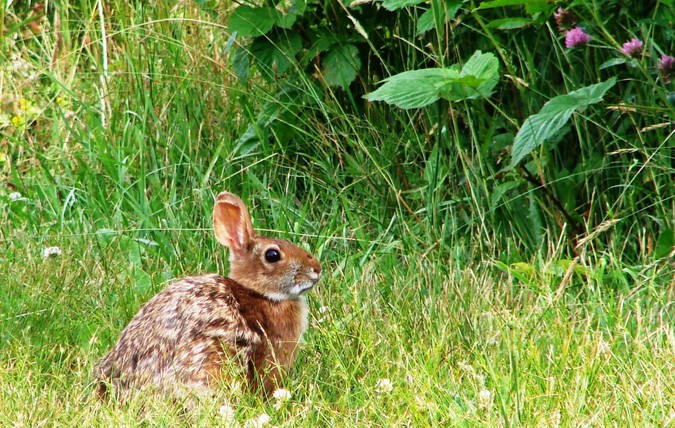The Wrack
The Wrack is the Wells Reserve blog, our collective logbook on the web.
The Wrack is the Wells Reserve blog, our collective logbook on the web.

It’s Easter Weekend, so let me introduce you to the Wells Reserve at Laudholm’s favorite, and most vexing, local bunny.
The New England cottontail once ranged across its namesake region. In colonial times, it was called “brush rabbit” or “coney.” (In New York City, there’s an island that must have been an amusement park for cottontails before the Dutch claimed it.) As early American farmland reverted to overgrown fields, the cottontails flourished. And then, over the past 75 years, as many of those fields matured back into forests, and the rest were planted with houses, the rabbits got squeezed out.
Biologists from state agencies, nonprofits and the federal government are desperately trying to save these vulnerable little creatures. But why do we spend so much time, money, and talent to protect these varmints? Why have we been working here at the Wells Reserve for more than a decade to create new scrubland (“rabitat”) for them, even though we haven’t actually caught one in years? Why are we trying, over the next year especially, to keep the New England cottontail off the endangered species list?
We recently marked the 40th anniversary of the Endangered Species Act, the keystone accomplishment of President Nixon’s environmental legacy that also included the Clean Air and Water Acts and the founding of the EPA and the National Oceanic and Atmospheric Administration, the federal parent of your friendly neighborhood reserve. The preamble to the Endangered Species Act (ESA) proclaims:
…species of fish, wildlife, and plants [threatened with extinction] are of esthetic, ecological, educational, historical, recreational, and scientific value to the Nation and its people…
It’s hard to overestimate the power of those prescient words. The ESA is a phenomenally successful piece of legislation; of the more than 2,000 threatened plant and animal species the Act has managed to list and protect to date, 99% have been saved from annihilation. Piping plovers, spotted owls, and Atlantic salmon live on thanks to the ESA.
But those names can also conjure thoughts of heavy fines, lost jobs, ghost towns and government clampdowns. Those are the “cons” of wildlife conservation, but what are the pros? Here are a few arguments conservation biology employs to save species:
But so what, says the cynic? Death is as inescapable as life: 95% of all species that ever lived are extinct. Dinosaurs and trilobites no longer roam the earth, thanks to meteors and climate change and other prehistoric calamities. Since about 100,000 B.C., science tells us that humans have been driving a sixth wave of worldwide extinctions. Brown bears, dodos, passenger pigeons, many fish and amphibians – all are casualties of our civilization’s spread. They lost; we won.
This past week was a holy one, so perhaps I’ll close Biblically. Faith draws its power not from science, but from belief and responsibility. What kind of dominion should we hold over the fish and fowl, beasts and creeping things? This Easter, with every bite of chocolate bunny, think of the New England cottontail, that meek inheritor of the wind, scampering about its ever-shrinking kingdom under Heaven.
We are as gods to these rabbits. Are we vengeful gods, or merciful ones?
This article was published in the Biddeford-Saco Journal Tribune Sunday edition, 4/20/2014, in the column, “Between Two Worlds,” ventures forth from the intersection of art and science, past and future, wascals and wabbits. More at wellsreserve.org/twoworlds.